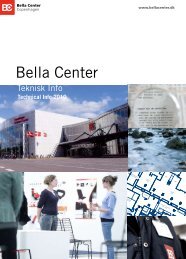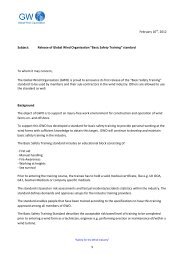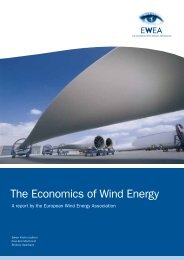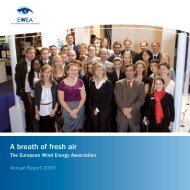Offshore Electricity Infrastructure in Europe - European Wind Energy ...
Offshore Electricity Infrastructure in Europe - European Wind Energy ...
Offshore Electricity Infrastructure in Europe - European Wind Energy ...
Create successful ePaper yourself
Turn your PDF publications into a flip-book with our unique Google optimized e-Paper software.
conclusions and recommendations<br />
• While the sum of the two cable capacities should<br />
be a little bit smaller than the w<strong>in</strong>d farm size, the<br />
<strong>in</strong>dividual cable sizes should be decided based on<br />
the price levels <strong>in</strong> the connected countries. The<br />
connection to the country with a higher assumed<br />
price level across the project lifetime should be<br />
larger than the connection to the country with a<br />
lower price level.<br />
• A detailed case study on the Cobra cable between<br />
Denmark and the Netherlands was carried out.<br />
Tee<strong>in</strong>g-<strong>in</strong> a German w<strong>in</strong>d farm to the Cobra cable<br />
is identified as beneficial from the po<strong>in</strong>t of view of<br />
<strong>Europe</strong>an welfare. The case study also confirmed<br />
the conclusion on the split connection of the large<br />
w<strong>in</strong>d farms: tee<strong>in</strong>g-<strong>in</strong> a 1300 MW <strong>in</strong>to the 700 MW<br />
Cobra cable proved to be the most <strong>in</strong>terest<strong>in</strong>g<br />
option.<br />
• Concrete guidel<strong>in</strong>es for pre-feasibility analysis on<br />
tee-<strong>in</strong> solutions have been def<strong>in</strong>ed and can be<br />
found on www.offshoregrid.eu.<br />
Recommendations on tee-<strong>in</strong> solutions<br />
• For large w<strong>in</strong>d farms/hubs far from shore, the<br />
opportunities for splitt<strong>in</strong>g the connection to two<br />
shores and creat<strong>in</strong>g an <strong>in</strong>terconnector at the same<br />
time should be <strong>in</strong>vestigated.<br />
• For small w<strong>in</strong>d farms that are considered to be far<br />
from shore (e.g. offshore w<strong>in</strong>d to supply oil and gas<br />
platforms), it should be <strong>in</strong>vestigated whether they<br />
can be teed-<strong>in</strong> to an <strong>in</strong>terconnector.<br />
• When decid<strong>in</strong>g between a tee-<strong>in</strong> solution and a<br />
split connection (one w<strong>in</strong>d farm connected to two<br />
shores), the rat<strong>in</strong>g of the cable sections at either<br />
side of the w<strong>in</strong>d farm should be carefully considered,<br />
based on an <strong>in</strong>dividual power market analysis.<br />
In order to reduce the constra<strong>in</strong>ts and maximise<br />
the benefits, the capacity should be highest at the<br />
side of the country which usually has the highest<br />
prices.<br />
• Interconnectors that are required for <strong>in</strong>ternational<br />
exchange or improv<strong>in</strong>g security of supply should<br />
not be delayed and they should be rated as optimal<br />
for these purposes. If future w<strong>in</strong>d farms are<br />
considered to be <strong>in</strong>stalled close to one of these<br />
<strong>in</strong>terconnectors, the technology and cable route<br />
should be anticipated to maximise the future benefits<br />
of the <strong>in</strong>tegrated solution.<br />
• If a w<strong>in</strong>d farm tee-<strong>in</strong> produces net benefits compared<br />
to the conventional connection of the w<strong>in</strong>d<br />
farm to shore, no technology should be ruled out<br />
a priori. The decision on which HVDC technology to<br />
use and on which technical set-up to favour should<br />
be based on the analysis of all costs and benefits<br />
<strong>in</strong>clud<strong>in</strong>g operational implications (e.g. fault handl<strong>in</strong>g,<br />
redundancy, etc), costs of <strong>in</strong>frastructure,<br />
electrical losses and available capacity rat<strong>in</strong>gs.<br />
• Tee-<strong>in</strong> connections are technically feasible and<br />
economically beneficial <strong>in</strong> many cases. However,<br />
<strong>in</strong>compatible regulatory frameworks and support<br />
schemes can h<strong>in</strong>der construction as the developer<br />
is confronted with large uncerta<strong>in</strong>ties, <strong>in</strong> particular<br />
<strong>in</strong> regard to the support or capital attraction due to<br />
difficult connection barriers. In particular when the<br />
w<strong>in</strong>d farm <strong>in</strong> question is connected to an <strong>in</strong>terconnector<br />
that does not start or end <strong>in</strong> the country <strong>in</strong><br />
which the w<strong>in</strong>d farm is built, national states might<br />
be reluctant to support the solution if the renewable<br />
energy generation is not credited to them.<br />
These political, support scheme and regulatory<br />
framework issues need special attention <strong>in</strong> the<br />
com<strong>in</strong>g years <strong>in</strong> order to make tee-<strong>in</strong> solutions<br />
possible.<br />
6.3 Hub-to-hub solutions<br />
Key Results on hub-to-hub solutions<br />
• Connect<strong>in</strong>g countries via offshore w<strong>in</strong>d farm hubs<br />
requires VSC technology and circuit breakers on<br />
a platform as fault propagation has to be limited.<br />
This is <strong>in</strong> particular necessary <strong>in</strong> order to ma<strong>in</strong>ta<strong>in</strong><br />
a high grid operation stability and security of supply<br />
level.<br />
• Whether a hub-to-hub solution is beneficial over a<br />
direct <strong>in</strong>terconnector depends on the associated<br />
constra<strong>in</strong>ts for <strong>in</strong>ternational power exchange and<br />
the substituted <strong>in</strong>frastructure costs. While the<br />
<strong>in</strong>tegrated solution reduces the possibilities for<br />
trade (trade constra<strong>in</strong>t), the <strong>in</strong>frastructure costs<br />
92 <strong>Offshore</strong>Grid – F<strong>in</strong>al Report









